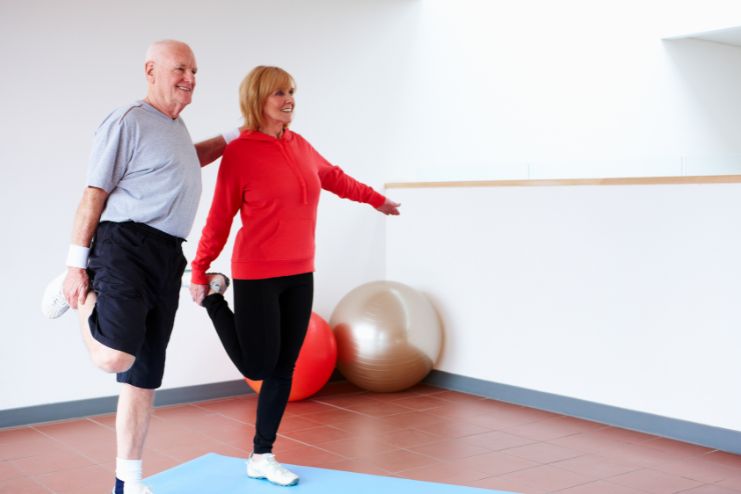Affiliate Disclaimer
Some links in this article are affiliate links. We may earn a small commission if you make a purchase through these links, at no extra cost to you. We only recommend products we find useful to our readersExercise is essential for cancer management since it significantly improves mental and physical health. Cancer treatments can frequently cause fatigue, reduced mobility, and emotional distress, but regular physical activity increases energy levels, reduces side effects, and improves overall quality of life.
Exercise is vital to cancer treatment by improving circulation, lowering inflammation, and boosting immunity. Since every person’s experience with cancer is different, customized exercise regimens are essential for considering various energy levels and medical conditions.
Walking, yoga, and light stretching are low-impact exercises that can have a significant impact without taxing the body. However, under expert supervision, people with higher stamina could benefit from strength training or aerobic activities. Cancer patients can develop resilience, restore confidence, and feel more in control of their health with customized routines.
Read Here: Cancer-Fighting Recipes: Nutrient-Packed Meals for Wellness
Benefits of Exercise During Cancer Treatment
You might believe that resting is crucial while undergoing cancer treatment or recovering, yet studies have shown that exercise helps the majority of cancer patients.
Doctors have long advised exercise to lower the risk and support cancer survivors in their post-treatment lives. However, what about working out while undergoing treatment?
The American Society of Clinical Oncology (ASCO) also recently released the first-ever evidence-based exercise recommendations for persons undergoing active cancer treatment.
“Center for Energy Balance in Cancer Prevention and Survivorship at MD Anderson is led by Karen Basen-Engquist, Ph.D. “We lacked guidelines on what to say to patients who inquired about exercising while undergoing therapy. We do now.
ASCO assembled a group of specialists to create the guidelines, and they examined over 100 research trials on the relationship between exercise and cancer treatment.
Their findings made it clear that patients receiving radiation therapy, chemotherapy, or both benefit from maintaining an active lifestyle in terms of reducing side effects and symptoms. Additionally, it facilitates a quicker and less complicated recovery for surgical patients.
According to Basen-Engquist, “research indicates that physical activity during cancer treatment improves physical function and quality of life while reducing fatigue, anxiety, and depression.” “Remaining active enables patients to carry on with their daily routines.”
According to the guidelines, patients whose cancer has not spread beyond its original site should engage in regular aerobic exercise, such as walking, running, or cycling, and strength training, like lifting weights or using resistance bands.
Read Here: Best Foods to Eat for Cervical Cancer Prevention
Tailoring Workouts for Health and Energy
Low-Impact Exercises:

Cancer patients who feel tired or have limited movement should do low-impact activities. When you engage in low-impact exercise, your body moves without the jarring, slamming, and jumping that come with other, more complex types of exercise. Low impact means that.
Your joints will be little affected, if at all. When performing standing or sitting exercises, one or both feet will always be in contact with the ground; when swimming or sitting, there won’t be any impact or jarring anywhere on your body.
Gentle movements in yoga, tai chi, and walking encourage balance, flexibility, and relaxation without putting the body through unnecessary strain.
Walking differs from running in that at least one foot is always in contact with the ground; there is no flight phase during walking.
Additional advantages of yoga include increased strength and balance. It can also increase your heart rate, which is good for your heart. Make sure to begin slowly. Working with a certified yoga instructor is a good idea to ensure you are doing the poses correctly.
These exercises are a fantastic method to stay active while lowering stiffness and increasing circulation, and they can be readily adjusted to accommodate different energy levels.
Strength Training:

When incorporated into a cancer care regimen, strength training can help preserve muscle mass, which may decrease following cancer treatment. Research shows that exercise bands can produce the same strength improvements as traditional resistance training with weights. Additionally, they can aid in weight loss, blood pressure reduction, and brain function enhancement.
Additionally, strength exercise improves metabolic health, lowering the danger of muscle loss and supplying energy. To guarantee safety and efficacy, a medical practitioner or fitness expert should supervise as you begin with manageable weights and gradually advance.
Read Here: How to Identify Cancerous Moles: Signs You Shouldn’t Ignore
Aerobic Workouts:

According to research, exercise is very safe and beneficial for most people before, during, and after cancer treatment. It can help you have more energy to perform the activities you enjoy and enhance your quality of life. Engaging in physical activity also enables you to manage the adverse effects of treatment and lowers your chance of developing new cancers.
Prolonged sitting or rest can result in muscle weakening, decreased range of motion, and loss of bodily function. Before, during, and after cancer treatment, many cancer care teams advise their patients to engage in as much physical activity as feasible.
Without overtaxing the body, moderate-intensity aerobic activities such as swimming, cycling, or brisk walking are great for cardiovascular health. Aerobic exercise strengthens heart and lung function, improves oxygen circulation, and boosts endurance. Even brief (10–20 minute) sessions can significantly impact cancer patients.
After chemotherapy and/or radiation therapy, patients with solid tumors who engage in aerobic exercise for six weeks report feeling less fatigued from their malignancy.
Flexibility and Balance Exercises:

After receiving a cancer diagnosis, exercising could be the last thing on your mind. Exercise can become one of your favorite things, even if you have never been active. Learning to exercise correctly is crucial for cancer survivors, as more healthcare providers advise their patients to do so.
Stretches and range-of-motion (ROM) exercises are other names for flexibility exercises, which lengthen tendons and muscles. They preserve or increase muscle and joint suppleness. As we age, our joints and muscles gradually become less flexible, but cancer therapies can also affect these areas. Frequent stretching can postpone any loss of flexibility and aid in overcoming stiffness.
Balance and flexibility exercises are very essential for avoiding injuries and preserving mobility. Stretching exercises, yoga positions, and Pilates can improve flexibility by expanding the range of motion in joints and muscles. Standing on one leg or using the stability balls enhances coordination and lowers the chance of falling.
Read Here: 10 Early Warning Signs of Cervical Cancer You Shouldn’t Ignore
Incorporating Exercise Safely
Beginning an exercise regimen while undergoing cancer treatment requires considerable preparation and medical advice. Before starting physical activity, patients must speak with their healthcare professionals to guarantee safety and choose the best activities. Doctors can provide tailored advice depending on the type of cancer, the course of therapy, and the patient’s general health.
The secret is to increase activity levels gradually. Light, reasonable activities should be the first thing patients do, and they should pay great attention to their bodies. Overexertion can be avoided by incorporating brief sessions and modifying intensity according to energy levels. Rest days are equally as vital as days of activity because they give the body time to heal and rejuvenate.
Attention to warning indicators such as lightheadedness, dyspnea, or unusual pain is critical. If any troubling symptoms appear, exercise should be stopped, and medical help should be sought. Cancer patients can safely enjoy the many advantages of regular exercise while promoting healing by remaining conscious, taking it slow, and making the required changes.
Read Here: 9 Daily Habits That May Reduce Cancer Risk
Conclusion
Including customized exercise regimens in cancer treatment can improve patients’ mental and physical health. Physical activity has many advantages, ranging from lowering fatigue and controlling adverse medication effects to increasing muscle strength and resilience in general. Since every patient’s path differs, selecting exercises complementing their health and energy levels is critical.
Healthcare professionals advise cancer patients to start with mild workouts like yoga, swimming, or walking and gradually progress to strength training or aerobics as their endurance increases. Seeking advice from medical experts guarantees safe, individualized exercise regimens that optimize the benefits of physical activity.
By embracing exercise as a supporting component of their treatment strategy, individuals can improve their quality of life, gain confidence, and take control of their cancer journey.
References
- https://www.cancercouncil.com.au/cancer-information/living-well/exercise-cancer/
- https://www.cancervic.org.au/get-support/living-with-cancer/exercise/exercise-overview
- https://www.mdanderson.org/cancerwise/exercise-during-cancer-treatment–4-things-to-know.h00-159543690.html
- https://www.dana-farber.org/health-library/tips-for-exercising-during-after-cancer-treatment
- https://www.mskcc.org/podcasts/cancer-straight-talk/how-exercise-can-help-treat-and-prevent-cancer
- https://www.asco.org/
- https://faculty.mdanderson.org/profiles/karen_basen-engquist.html
- https://www.verywellhealth.com/low-impact-exercise-5216089
- https://www.mskcc.org/cancer-care/patient-education/exercise-during-after-cancer-treatment-level-1
- https://www.cancervic.org.au/get-support/living-with-cancer/exercise/strength-training-exercises
- https://www.massgeneralbrigham.org/en/about/newsroom/articles/how-to-build-strength-with-resistance-bands
- https://www.cancer.org/cancer/survivorship/be-healthy-after-treatment/physical-activity-and-the-cancer-patient.html
- https://www.oncolink.org/support/exercise-cancer/aerobic-exercise-program-during-and-after-cancer-treatment
- https://pmc.ncbi.nlm.nih.gov/articles/PMC5661333/
- https://triagecancer.org/balance-exercises
- https://www.cancervic.org.au/get-support/living-with-cancer/exercise/flexibility-exercises
- https://www.cancercouncil.com.au/cancer-information/living-well/exercise-cancer/balance-exercises/
In this Article

















